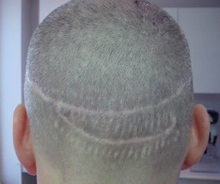Fixing and Repairing Hair Transplant Scars
Hair transplant procedures that use follicular units exclusively leave no visible scarring in the recipient area. In Follicular Unit Transplantation (FUT), there is a single thin line in the donor area where the strip was removed. In Follicular Unit Extraction (FUE) there are multiple tiny round, white scars in the donor area, one for each extracted follicular unit. Generallythese scars are undetectable and are of no cosmetic consequence to the patient.
When older methods of hair restoration surgery are used, current techniques are performed improperly or, less commonly, when a patient is a poor healer, scarring may be excessive and may present a cosmetic problem. The scarring may be due to the plug itself (which invariably leaves a round white scar), it may be caused by the elevation or depression of grafts (seen with some slit and minigrafting techniques), or it may be due to a stretched or thickened donor scar.
Scarring in the recipient area can be eliminated by keeping recipient sites very small. Sites such as those used in FUT and FUE, will not leave any visible marks. Scarring in the donor area can be minimized by meticulous closures, where the wound edges are perfectly approximated and are under little or no tension. Using an inert material to close the wound, such as stainless steel staples, also helps to minimize the destruction of hair follicles and the incidence of hair transplant scarring.
When significant scarring does result, a number of techniques are available to reduce it. The two most effective methods are scar revision (excising or changing the direction of a hair transplant scar) and camouflage (a technique where hair is transplanted directly into the scar). In addition, thickened scars may be flattened with cortisone injections, depressed scars may be raised with dermal fillers and an irregular surface may be made smoother with dermabrasion or laser treatments.
The method for fixing hair transplant scars must be tailored to the specific situation, since each hair transplant repair patient has unique problems which influence the approach. Perhaps the most significant issue is the amount of remaining donor hair reserves. The following examples illustrate a number of common techniques used to improve scarring.
For some instead of just covering it up their scar, they just want to get rid of the problem entirely, that is why they opt for scar revision surgery. In this procedure, the scar is removed and the scalp is pulled back together. There will still be some scarring but it will be much smaller than the original.
Follicular Unit Extraction (FUE) is a great method of concealing hair transplant scars. This time, the donor grafts are taken from the beard or chest hair and then implanted on the scar and given time to grow. Those with a high hair density in other areas of the body are considered to be the best candidates for this treatment. Usually 50% to 90% of the grafts grow in scars, making the scarred areas of the scalp much less visible.


Before your hair transplant surgery, discuss hair transplant scar treatments available to your surgeon. Your hair transplant surgeon can help minimize scarring by using a certain closure technique. If you have more questions about fixing hair transplant scars or to find out more about what can be done for thinning hair, please don’s hesitate to contact us at (817) 473-2120 or visit our website at www.markbisharamd.com.



